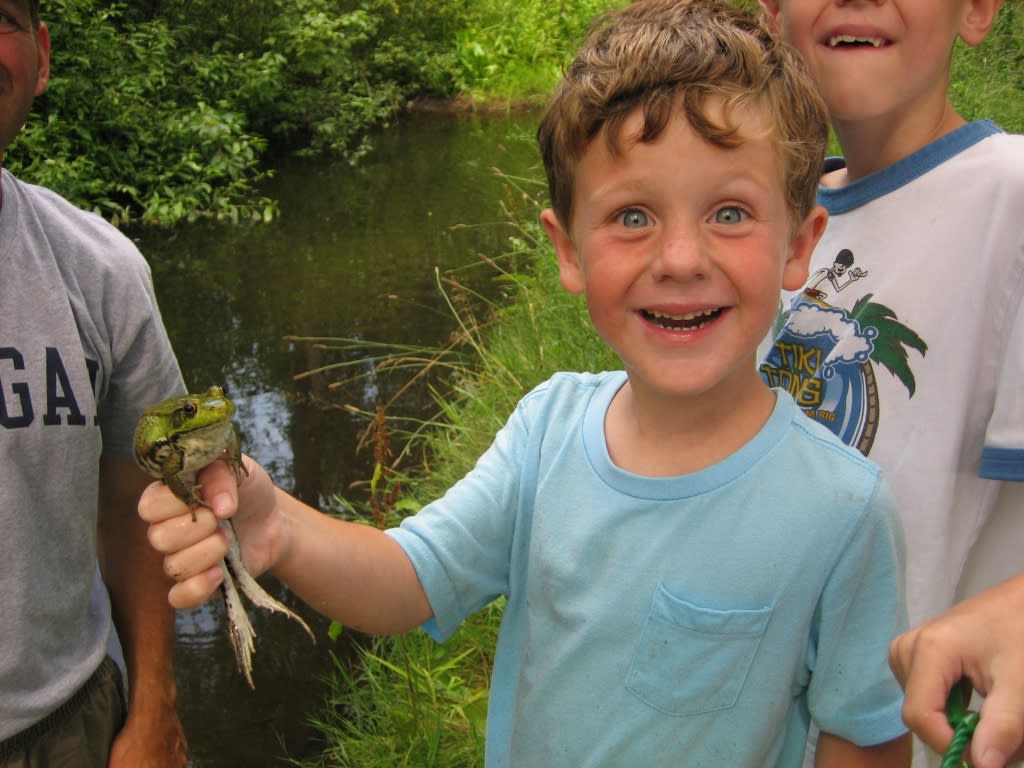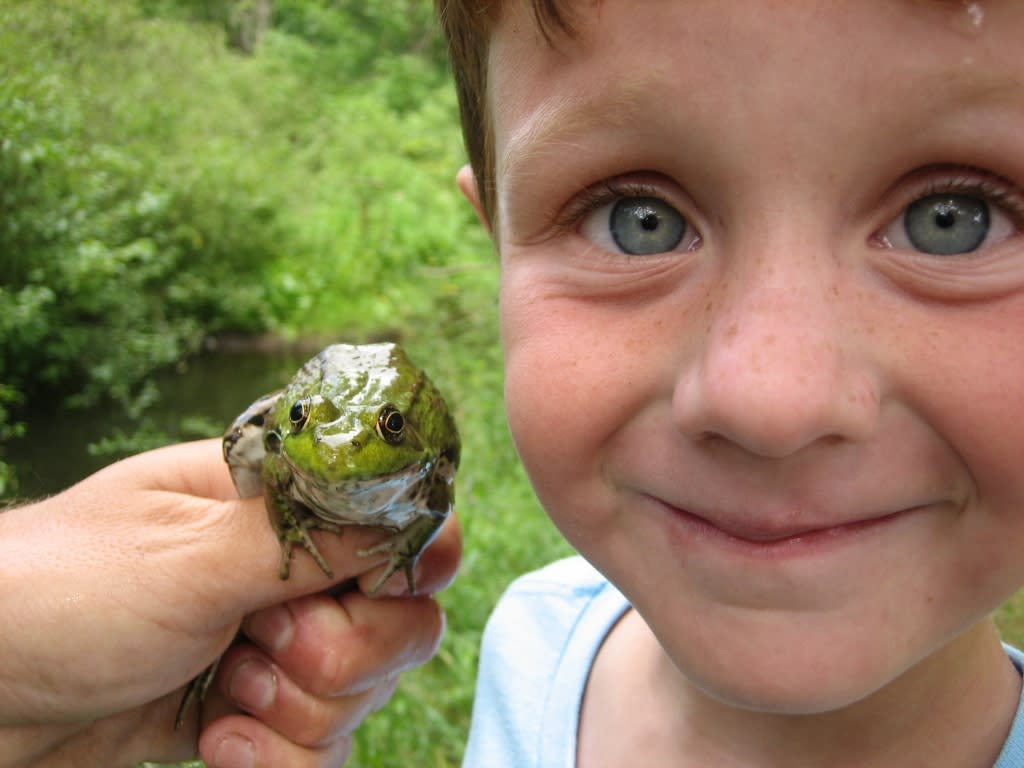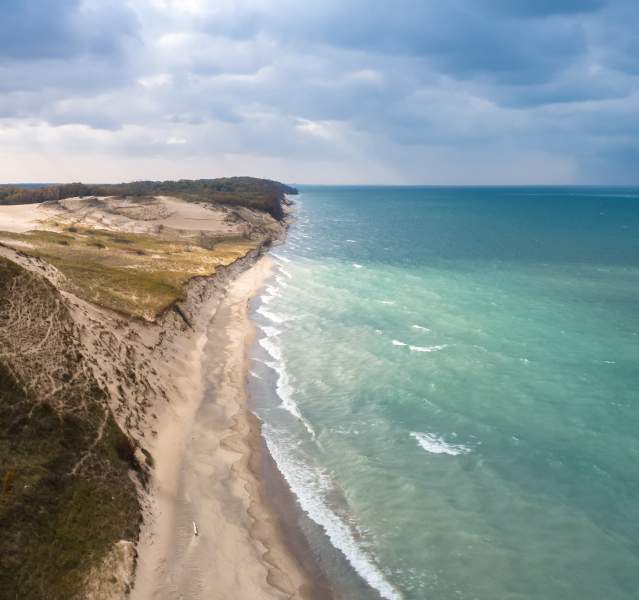Catching Joy - Leopard Frogs
By Alyssa Nyberg
I vividly remember catching my first frog. I was nine years old and was visiting my cousin who lived in rural Ohio. My cousin had just caught a toad and after many tries, I caught a frog…a real frog! (My cousin had much more experience in frog and toad catching than I, she knew full well that a dry toad was much easier to keep hold of than a slippery frog.)
What a joy it was to look into the eyes of something “wild” and have it look back! We had a great day of exploring, reading by the pond, and daydreaming in the woods with our amphibian friends until it was time to set them free and go inside for dinner. What a transformative day that was for me. From that day on, spending time with wild creatures in their natural habitat was something that I wanted to continue to do forever.
 - Catching frogs at Kankakee Sands.
- Catching frogs at Kankakee Sands.
And fortunately, at Kankakee Sands, I get to do just that. In the spring, when the nighttime temperatures are above 45 degrees and the air becomes thick with the sweet songs of frogs calling from the wet ditches, depressions and ponds of Kankakee Sands, I can’t help but think of that spring visiting my cousin.
In our Kankakee Sands area, there are ten species of frogs and toads that might be calling during spring evenings. As you might imagine, frogs are difficult to identify by sight in the dark; luckily, frogs and toads are easily identified by their calls, like the high pitched ‘peeeeeep’ of the spring peeper or the plucked banjo string ‘plounk’ call of the green frog.
Why do frogs make these calls? To attract a mate. How else would you find a lover in the dark of night? Frogs will call during their mating season in the spring, then quiet down for the summer and fall and finally hibernate in the winter.
One of the quietest members of the spring frog symphony, and one of the most abundant at Kankakee Sands, is the northern leopard frog (Rana pipiens). It is the frog you are most likely to see hopping ahead of you on the trail or bounding across the road, legs dangling behind when it is airborne.
The mating call of the northern leopard frog is a low, quiet rattling snore that lasts about 3-5 seconds and is followed by a ‘chuckling’. You can replicate the northern leopard frog’s call by slowly rubbing your thumb against a wet balloon. The northern leopard frog’s call is one of the quietest calls of all the frogs in our area. The call is often overpowered by the more robust calls of the other frog species. However, because the northern leopard frog is less secretive than other breeds, it is relatively easy to find one at Kankakee Sands.
The northern leopard frog is 2 -3.5 inches in length. Its base color can range from bright green to an olive green-brown. On its back are dark rounded spots that resemble the spots of a leopard. Another key marker of the leopard frog is the dorsolateral ridges--two lightly colored, parallel ridges that extend down the body from the neck to the hips.
The female northern leopard frog lays eggs in water. As she lays her eggs, the male fertilizes them. Up to 6000 eggs are laid in a globular mass and attached to plant stems for stability. In 13-20 days, the tadpoles hatch, and when they do, they are dark grayish brown with golden flecks. Once they hatch they are on their own, as the female does not care for the young. (If you ever thought it was overwhelming to care for one baby, imagine trying to care for 6,000!) Over the next 70-100 days, the tadpoles will transform into adults, slowly growing legs and absorbing their own tail. The rate of tadpole’s development is dependent on the temperature of the water. The warmer the water, the faster the development.
A northern leopard frog’s diet consists of insects, spiders, slugs, earthworms, and occasionally other smaller frogs. In turn, the northern leopard frog is part of the diet of birds, snakes, bull frogs, and small mammals such as the raccoon and opossum.

The historical range of the northern leopard frog in Indiana was throughout the north, central, and southeast part of the state, in freshwater sites with ample vegetation such as wetlands, marshes, ponds and moist fields. Over the past thirty years, leopard frog populations have declined so dramatically that now the northern leopard frog is listed as a ‘species of special concern’, which means it is being monitored but not yet managed as a protected species. Although the populations of northern leopard frogs are declining across the state, its numbers are very high in our area in part due to the many natural areas in northwest Indiana.
Come to Kankakee Sands and experience the joy of catching a frog. Bring your little ones out to Kankakee Sands on Thursday, June 15 or Saturday, June 17 2017, from 10 am to noon to catch a frog as part of the Nature Play Days children’s program, https://www.indianachildrenandnature.org/ Please RSVP for the event to Alyssa Nyberg at anyberg@tnc.org or 219-866-1706.
During the program, we will discuss the frogs of our area, practice their calls, and go out to do the age-old, timeless act of catching a frog, holding it in our hands, and watching it hop away. And then we will wonder if maybe, just maybe, we’ve transformed the lives of the next generation who will love and care for our natural world.
________________________________________________________________________
The Nature Conservancy’s Kankakee Sands is an 8,300-acre prairie and savanna habitat in Northwest Indiana, open every day of the year for public enjoyment. For more information about Kankakee Sands, visit www.nature.org/KankakeeSands.

